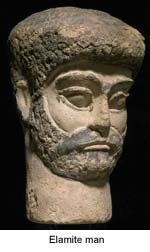|
|
 From 9000 - 2000 B.C. there were many cultures and tribes ruling the area. From 9000 - 2000 B.C. there were many cultures and tribes ruling the area.
Īlām (Elamites) in Between caspian sea and Persian golf, in Zāgros (Zagros) mountain.
Sūmer (Sumer) in south of Beinol Nahrein (Mesopotamia).
Akkad in current north and central Arāqh (Iraq).
Āshūr (Asyria) in Iran's Āzarbāījān (Azerbaijan) and Sūrīeh (Syria).
Hīt (Hitties) current Turkey
|
| Important events | |
Prophet Nūh (Noah)First city built at Susac. 3900 B.C.Sumerians invent the wheel (4000-3500 B.C.)Rise of Egypt (4000-3500 B.C.)Egyptians develop the Solar calendar and build elaborate tombs - pyramids (3000 - 2500 B.C.)Invention of writing called Proto-Elamite in Jiroft, 3300 B.C.Invention of writing on clay tablets 3000 B.C.The Haji Firuz Tepe Wine Jar, discovered in Iran, is the oldest archaeological finding of wine-making in the world. (5000 B.C.) |
|
|
Early Farming Communities 9000-5000 B.C.
9000 B.C. - Beginning cultivation of wild wheat and barley and domestication of dogs and sheep; inaugurating of change from food gathering to food producing culture - Kārīm Shāhīr (Karim Shahir) in Zagros foothills.
7000 B.C. - At Jarmo, oldest known permanent settlement: crude mud houses, wheat grown from seed, herds of goats, sheep, and pigs.
6000 B.C. - Migration of northern farmers settle in region from Babylon to Persian Gulf. Hassuna culture introduces irrigation, fine pottery, permanent dwellings; dominates culture for 1000 years, develops trade from Persian Gulf to Mediterranean.
Īlām (Elamite) is forming
|
Pre-Sumerians 5000-3500 B.C.
5000 B.C. - Ubaidians develop first divisions of labor, mud brick villages, first religious shrines. Small temple at Eridu - earliest example of an offering table and niche for cult object.
4500 B.C.
4000 B.C. - Semitic nomads from Syria and Arabian peninsula invade southern Mesopotamia, intermingle with Ubaidian population Temple at Tepe Gawra built - setting style for later examples.
Bronze Age
|
Sumerians 3500-2000 B.C.
3500 B.C. - Sumerians settle on banks of Forāt (Euphrates) Temple at Eridu - zigguratprototype
First cities are build in Īlām and Sūmer
3500-3100 B.C. - The first city-states evolve during the Uruk Period
3000 B.C. - Democratic assemblies give way to kingships, evolve into hereditary monarchies.
Kish - leading Sumerian city Introduction of pictographs to keep administrative records.
3-D statues, e.g. Warka head.
White Temple - ziggurat traditional design.
Temple at Tell Uqair - mosaic decorations.
cuneiform land sales formal contracts.
Eridu and Kish - simple palaces.
"Standard of Ur" - war-peace plaque, religious statues, gold and silver artifacts buried in tombs of Ur.
Sumerians of Abu Salabikh - first poetry.
Īlām (Elamite) reached Literacy by 3000 B.C., Its capital, Sūsh (Susa) exercised considerable influence in Valley affairs.
2750 B.C. - Gilgamesh (king of Uruk Dynesty), hero of Sumerian legends, reigns as king of Erech
2700 B.C. - A flood devastates Mesopotamia. This is probably at the same time as Nūh (Noah)
2500 B.C. - Lugalannemudu of Abab unites city states which vie for domination for 200 years.
Reign of Sargon - founder of the Akkadian Empire.
Indo-Europeans (Hittites) enter Asia Minor
2200 B.C. - The Akkadian Empire collapses 2112-2095 B.C. - Ur-Nammu founds Ur's 3rd. dynasty; dedicates ziggurat at Ur moon-god Nanna, sets up early law code. Gudea, Prince of Lagsh, art and lit patron,magnificant statues produced in his honor.
Susa becomes part of Elam
2000 B.C. - Īlām (Elamites) attack and destroy Ur.
|
Īlām (Elamites) 6000-1000 B.C.
Īlām (Susiana)
According to Mesopotamian texts the Eastern part of their land - Īlām - was occupied by a people called the Elamites. Indigenous to the country, and speaking an agglutinative non-Semitic language still not well understood to this day. Khuzestan was the center of their loosely organized federation of states which stretched north into Lurestan, south to Fars and as far as Bushehr on the Gulf.
Susa was always the pride and joy of the Elamites and later the Persians, a city that stood for 5000 years until totally sacked and raised to the ground by the Mongols in the 13th Century AD, maybe a reason why we have to refer to the Mesopotamian texts for the history of Īlām.
The Elamites' mountainous land gave them wood, marble, alabaster, lapis lazuli, metal ores, precious stones all of which were sought by the Mesopotamians who were rich agriculturally but short on raw materials. Susa soon became a trading center with routes stretching as far as Sistan, Balouchestan, Afghanistan and India.
The love hate relationship that existed between the Elamites and their Mesopotamian neighbors, the Assyrians, heightened circa 647 BC when Īlām, then a mighty kingdom, fell to Ashurbanipal. He recorded his devastation of Susa as an act of avenge for the humiliations the Elamites had inflicted on the Mesopotamians over the centuries. "I devastated the land of Īlām and on their lands I sowed salt" he said ......
NOTES: Important Elamite Cities such as Awan or Simash are still to be located. Other important Elamite sites however have been excavated such as Choga Zanbil, Haft Tepe and Susa on the Khuzestan Plain; and Anshan on the Marv Dasht plain near Persepolis in Fars.
|
|

